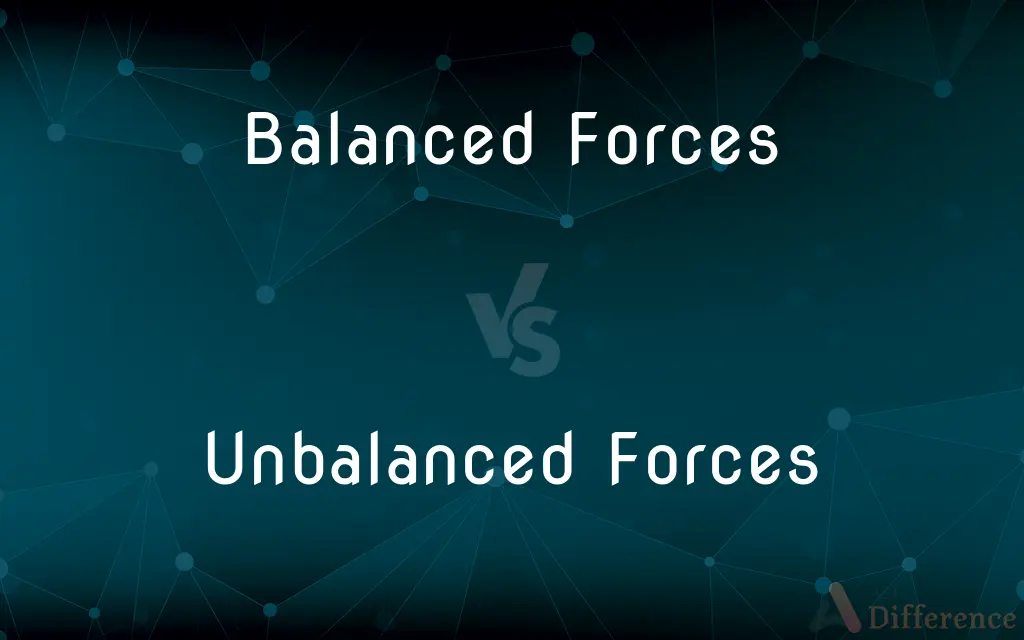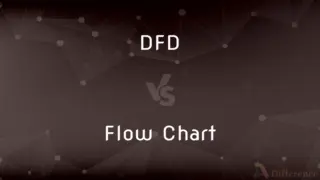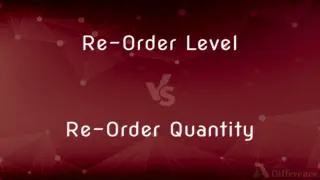Balanced Forces vs. Unbalanced Forces — What's the Difference?
Edited by Tayyaba Rehman — By Fiza Rafique — Published on December 25, 2023
Balanced Forces are equal in magnitude and opposite in direction, causing no motion. Unbalanced Forces have unequal strengths or directions, causing movement or change in an object's motion.

Difference Between Balanced Forces and Unbalanced Forces
Table of Contents
ADVERTISEMENT
Key Differences
Balanced Forces and Unbalanced Forces play pivotal roles in understanding motion and static situations in physics. While Balanced Forces keep an object at rest or in uniform motion, Unbalanced Forces cause a change in the object's velocity.
When considering Balanced Forces, it's essential to understand that their net force equals zero. This means that even if multiple forces act on an object, they cancel each other out, causing no acceleration. In contrast, Unbalanced Forces have a net force that isn't zero, resulting in acceleration or deceleration of the object involved.
An interesting attribute of Balanced Forces is that they don't change the state of motion of an object. If an object is at rest, it remains so; if it's in motion, it continues at a constant velocity. On the other hand, Unbalanced Forces disrupt this equilibrium, either initiating motion in a stationary object or altering the velocity of a moving one.
Everyday examples make the distinction clearer. When you push a wall with a force and it doesn't move, it's because the wall exerts an equal and opposite force, representing Balanced Forces. Conversely, if you push a toy car and it moves, it's due to the Unbalanced Forces at play.
In conclusion, while Balanced Forces maintain an object's state of motion, Unbalanced Forces alter it. Recognizing the difference between the two is foundational to the principles of mechanics.
ADVERTISEMENT
Comparison Chart
Net Force
Zero
Not zero
Result
No change in motion
Causes acceleration or change in motion
Magnitude and Direction
Equal in magnitude, opposite in direction
Unequal in magnitude or direction
State of Motion
Maintains current state (rest or constant velocity)
Alters state (initiates or changes motion)
Everyday Example
A book resting on a table
Pushing a sled on snow
Compare with Definitions
Balanced Forces
Equal forces acting in opposite directions.
Tug-of-war with two equally matched teams showcases Balanced Forces.
Unbalanced Forces
Forces resulting in a non-zero net force.
A ball rolling downhill because of gravity experiences Unbalanced Forces.
Balanced Forces
Forces that cancel each other out.
When two people push a box from opposite sides with equal strength, Balanced Forces are at play.
Unbalanced Forces
Unequal forces acting on an object.
When one person pushes a box harder than another, Unbalanced Forces are present.
Balanced Forces
Forces resulting in zero net force.
When the gravitational pull on a hanging object is countered by tension in the string, Balanced Forces exist.
Unbalanced Forces
Forces causing a change in motion.
The wind pushing a stationary boat into motion is due to Unbalanced Forces.
Balanced Forces
Forces that maintain an object's motion.
A car moving at a constant speed on a straight road experiences Balanced Forces.
Unbalanced Forces
Forces leading to acceleration or deceleration.
When you pedal a bicycle faster, you exert Unbalanced Forces on it.
Balanced Forces
Forces that don't cause acceleration.
The forces on a stationary object on a flat surface are Balanced Forces.
Unbalanced Forces
Forces changing an object's velocity.
When brakes are applied to a moving car, Unbalanced Forces slow it down.
Common Curiosities
What results from Balanced Forces on an object?
Balanced Forces lead to no change in an object's state of motion.
Do Unbalanced Forces always cause movement?
Unbalanced Forces cause a change in motion, which can mean initiating or altering movement.
What happens to a moving object under only Unbalanced Forces?
A moving object under Unbalanced Forces will either accelerate or decelerate.
Do Balanced Forces cause acceleration?
No, Balanced Forces do not cause acceleration.
Can objects at rest experience Balanced Forces?
Yes, objects at rest can have Balanced Forces acting on them, maintaining their state of rest.
How do Balanced Forces affect speed?
Balanced Forces maintain an object's current speed.
What dictates the direction an object moves under Unbalanced Forces?
The direction of the net Unbalanced Force determines the object's motion.
Are Balanced Forces always equal and opposite?
Yes, Balanced Forces are equal in magnitude and opposite in direction.
What's the net force when Unbalanced Forces act on an object?
With Unbalanced Forces, the net force is not zero.
Can Unbalanced Forces act in the same direction?
Yes, if forces of different magnitudes act in the same direction, they're unbalanced.
Why does a car slow down when brakes are applied?
The brakes introduce Unbalanced Forces, causing deceleration.
Is it possible for Unbalanced Forces to keep an object at rest?
No, Unbalanced Forces will always cause a change in the object's state of motion.
Can you have multiple Balanced Forces on one object?
Yes, multiple forces can act on an object and still be balanced if they cancel out.
How do Balanced Forces affect direction?
Balanced Forces don't change an object's direction of motion.
What role do Unbalanced Forces play in everyday life?
Unbalanced Forces are responsible for most changes in motion we observe daily, like starting, stopping, or turning.
Share Your Discovery

Previous Comparison
DFD vs. Flow Chart
Next Comparison
Re-Order Level vs. Re-Order QuantityAuthor Spotlight
Written by
Fiza RafiqueFiza Rafique is a skilled content writer at AskDifference.com, where she meticulously refines and enhances written pieces. Drawing from her vast editorial expertise, Fiza ensures clarity, accuracy, and precision in every article. Passionate about language, she continually seeks to elevate the quality of content for readers worldwide.
Edited by
Tayyaba RehmanTayyaba Rehman is a distinguished writer, currently serving as a primary contributor to askdifference.com. As a researcher in semantics and etymology, Tayyaba's passion for the complexity of languages and their distinctions has found a perfect home on the platform. Tayyaba delves into the intricacies of language, distinguishing between commonly confused words and phrases, thereby providing clarity for readers worldwide.











































